Punta Tombo, on Patagonia’s rugged Atlantic coast, is the best place to see penguins in Argentina.
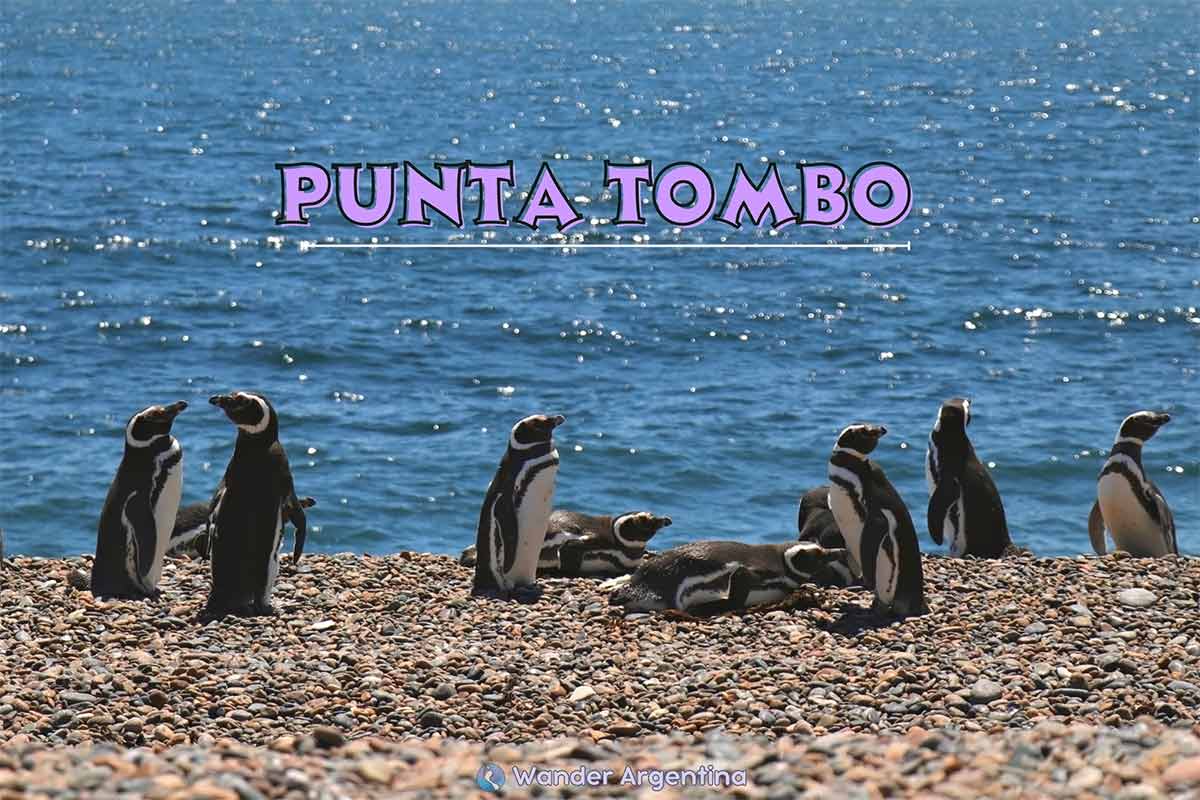
Nestled among the Patagonian steppe, 170 km south of Puerto Madryn, this is Argentina’s easiest-to-access penguin colony.
Why Go to Punta Tombo?
Punta Tombo comes alive in spring as delightful Magellanic penguins waddle between the sea and their nests, engage in theatrical displays of courtship and tenderly care for their young.
The penguins arrive around ‘Día de la Primavera,’ or ‘Spring Day,’ an unofficial holiday in Argentina.
After a very long 5,000 km swim, an estimated 100,000 males arrive at Punta Tombo’s colony to prepare their nests in anticipation of the arrival of the females, who arrive later.
In November, their chicks will be hatched.
While the penguin families enjoy their Punta Tombo summer vacations, the reserve also receives hundreds of thousands of human visitors, until March.
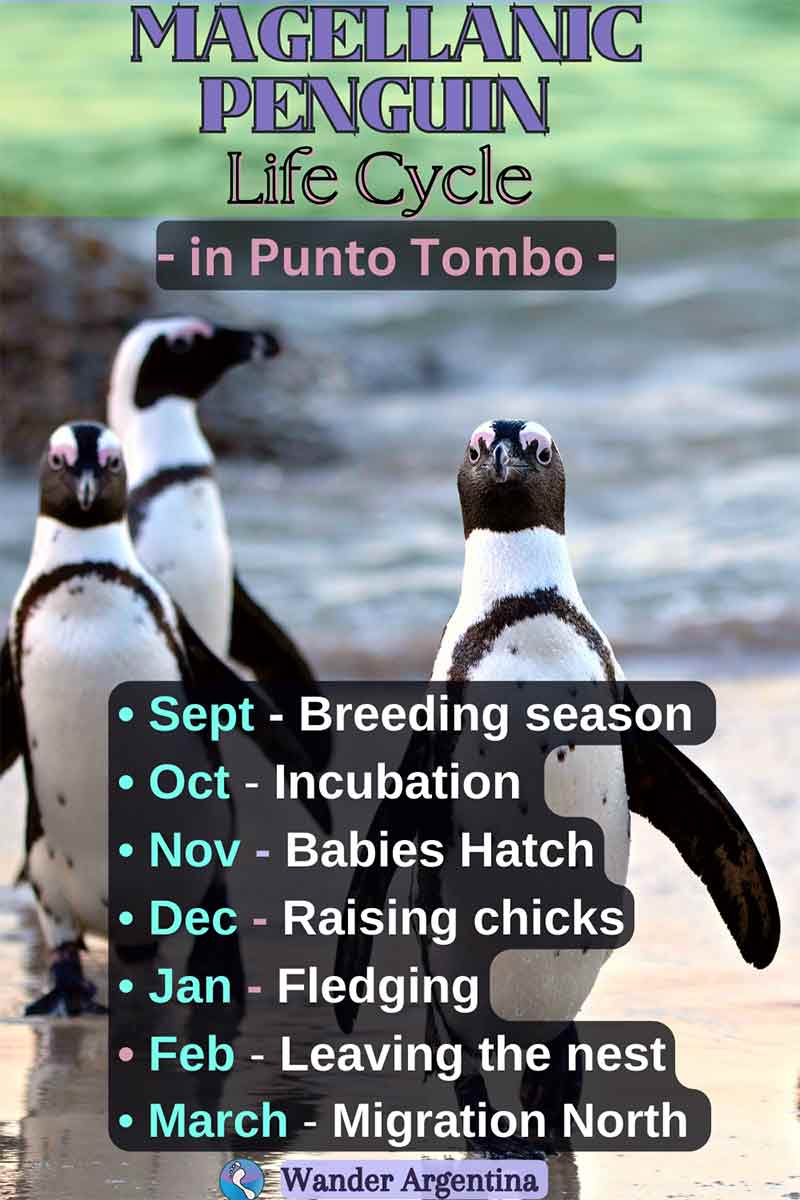
“After more than 20 years, penguins still surprise me!” says Dr. Ginger Rebstock, a penguin researcher with the Center for Ecosystem Sentinels.
In her twenty years of observing them, she says the distinct personalities of these delightful creatures never cease to amaze her.
The Remarkable Annual Journey to Punta Tombo
Magellanic Penguins (Spheniscus magellanicus) are one of 18 distinct penguin species.
Like other penguin species, they are flightless birds with powerful flippers instead of wings.
They can travel up to 170 kilometers (106 mi) per day in the ocean.
These intrepid ocean travelers navigate the vast seas, skillfully dodging cargo ships and fishing vessels on their annual 1,600 km (1000 mi) odyssey from their winter feeding ground along the southern coast of Brazil.
The Elegant Appearance of Magellanic Penguins
Dressed to impress, this penguin species is characterized by their elegant, contrasting plumage that makes them look as if they are wearing formal attire.
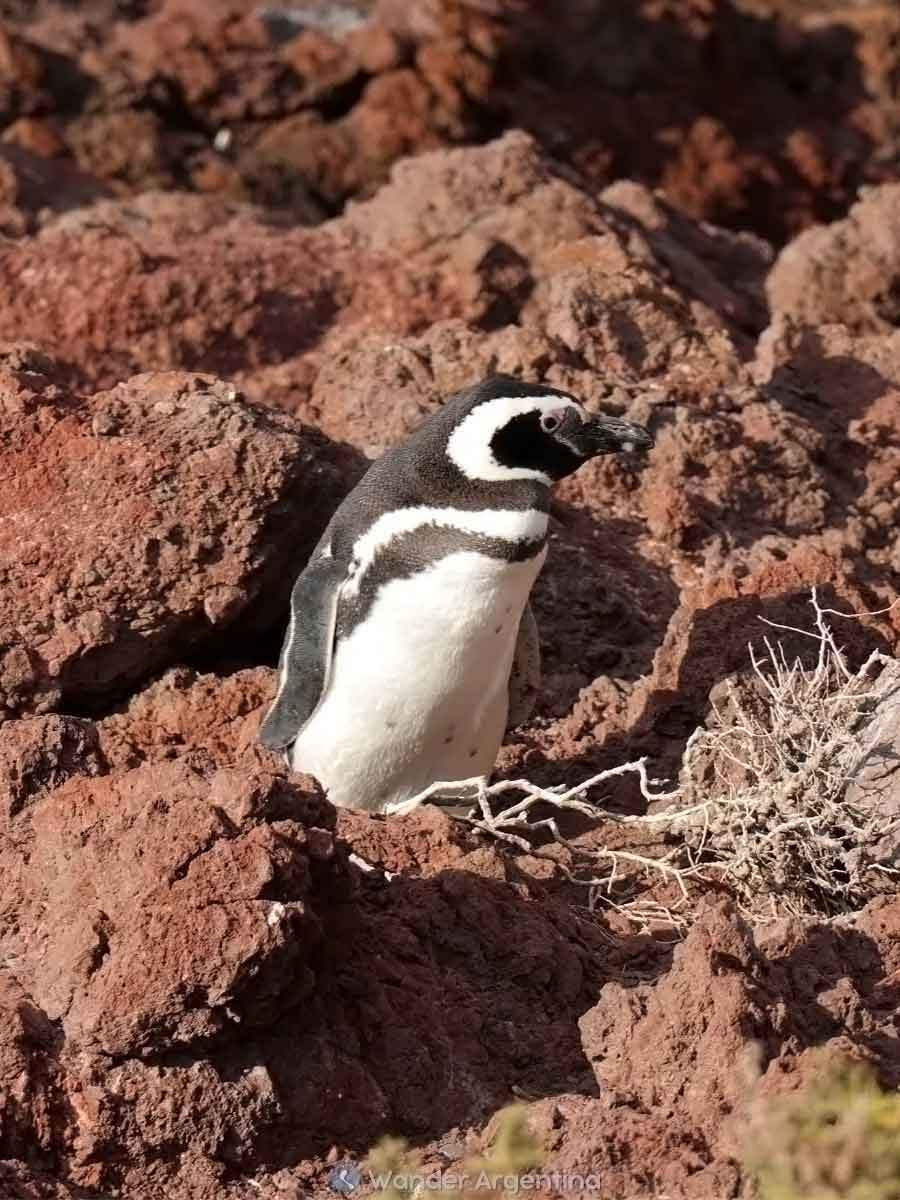
Their fancy ‘tuxedos’ give them effective countershading, allowing them to go unnoticed in the sea by predators above and below.
Magellanic penguins loyally stay with the same partner throughout their lives, with pairs maybe swimming their own way for a while but reuniting at Punta Tombo year after year.
Male penguins share equally in child rearing, building the burrow, brooding, and tag teaming to shuffle out to the sea to retrieve food for the family.
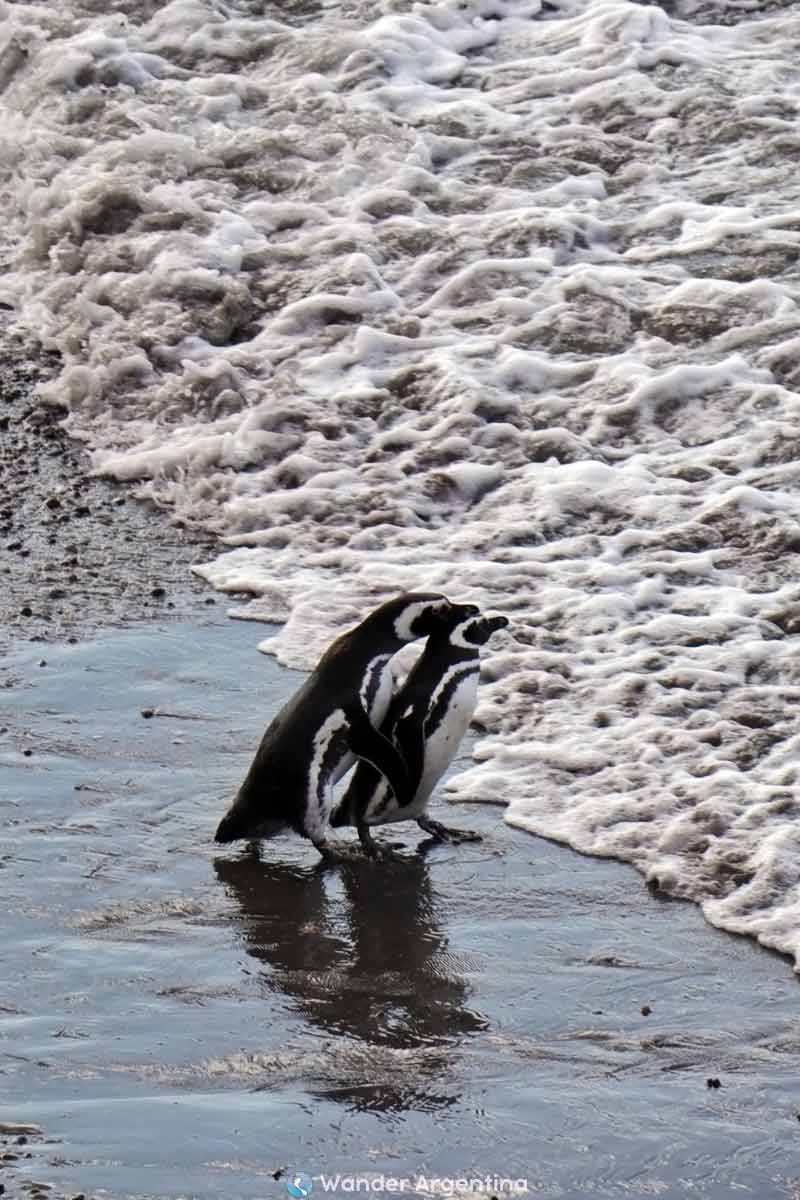
Penguins identify one another, including their mates, by their distinct, donkey-like call.
The loud braying vocalizations have earned them the nickname ‘jackass penguins.’
What is most unusual about Magellanic penguins is they have little fear of humans, and even exhibit a nonchalant curiosity about us.
Some of the penguins here such as Popi, Gerry and Gael are named by local school kids and tagged and tracked for their yearly migration, which can be viewed online via the Center for Ecosystem Sentinials.
Best Time to Visit
Penguins return to Punta Tombo between September and April to reproduce and hatch their eggs.
Tens of thousands of international tourists join them to observe these fascinating seabirds in their natural habitat while enjoying the South American spring and summer.
Punta Tombo National Reserve is open for visitors as long as the penguins are around.
With the arrival of the penguin flocks in September, the Penguin Festival unfurls over several days in nearby towns to celebrate their arrival.
Each part of the season provides a chance to observe the different life cycles of the penguins.
“Really, anytime the penguins are there — October through March or when the reserve closes around Easter— has its own charms, ” says Rebstock.
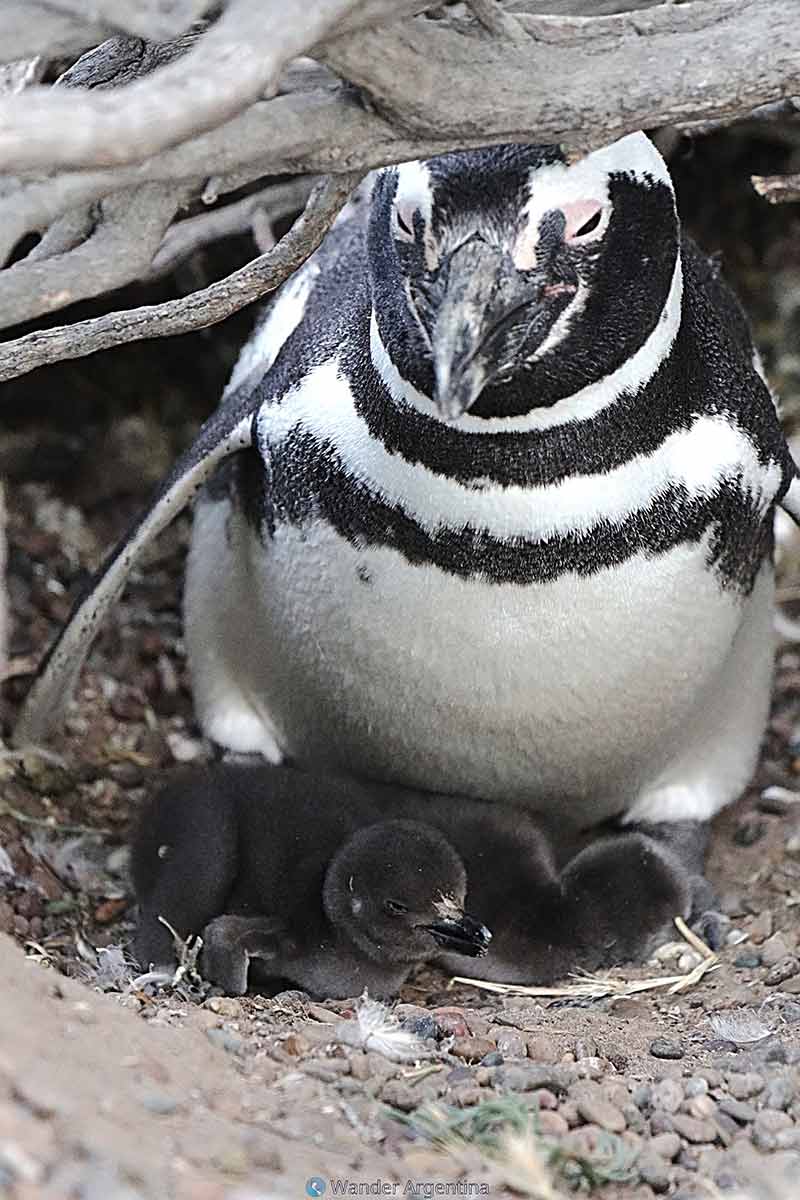
Most international tourists visit the area in the spring months (October—November), when whale and penguin-watching seasons overlap.
Penguin Life Cycle at Punta Tombo
Early in the season, the penguins are busy: locating their mates, building burrows, and occasionally fighting as a prelude to breeding.
In early October males are noisy and fight over their nests.
Mid to late spring they are incubating their eggs, while their mate goes out to sea to fill up on krill.
Later in the season, they are rearing chicks.
October and the beginning of November are peak season for international tourism but during this time half the penguin pairs are at sea while the others stay home and protect the nest.
For those visiting exclusively to see penguins, January is the ideal time to visit Punto Tomba Rebstock says, “That’s when the chicks are out of the nests and just adorable.”
In February the chicks transition into juveniles, molting their downy wings and beginning to explore further away from the nest.
By March, the young penguins have grown sleek new wings and can be seen practicing their strokes for their upcoming aquatic adventure to Brazil.
How Magellanic Penguins Colonized Land
Punta Tombo is a narrow, rocky strip about three kilometers (1.8 mi) long and 600 meters (1969 ft.) wide that extends into the Atlantic.
Penguins have only inhabited Punta Tombo for 100 years.
On land they have formidable predators such as pumas and foxes, so they previously only colonized islands.
But Punta Tombo’s penguins found an unexpected ally in sheep ranchers, who settled here in the early 20th century.
When the ranchers cleared out predators to safeguard their flocks, they unwittingly rolled out the red carpet for curious penguins to settle on the mainland.
Other residents of Punta Tombo are llama-like guanacos, grey foxes, big hairy armadillos, lesser grisons, which are like a more exotic honey badger, southern mountain cavy, Patagonian mara and rheas and 180 species of migrating birds.
The Fascinating Story of How Punta Tombo Became a Wildlife Sanctuary
Declared a nature reserve by the government of Chubút in 1972 Punta Tombo offers a comfortable habitat for penguins and serves as a Latin American model for eco-tourism.
Further key protection of the came with the 2015 designation UNESCO Patagonia Azul Biosphere Reserve which protects a massive surrounding marine area the size of Maryland.
But it wasn’t long ago that penguins were seen as a resource to be exploited instead of a unique species in need of protection.
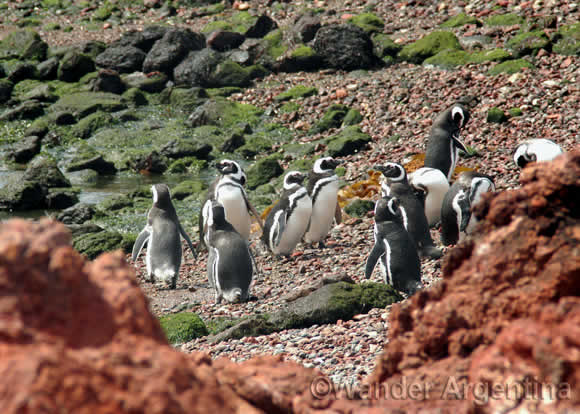
In 1982 a Japanese company petitioned the government to harvest Punta Tombo’s penguins for meat and skins.
The Wildlife Conservation Society hired biologist, Dr. Dee Boersma to study the penguin population here to see if the business would be sustainable.
Boersma and her colleagues determined that the commercialization of them would quickly make the penguin population at Punta Tombo extinct.
This crucial finding not only saved the penguins from becoming golf gloves but also marked the beginning of long-term wildlife research and further conservation efforts.
Save the Penguins: A Battle Against the Odds
Amidst the windswept shrubbery of the Atlantic coastline, researchers work diligently at Punta Tombo every year.
Their work involves weighing, logging, doing health checkups, and increasingly tracking with geotags to determine the ‘whose who’ in the Punta Tombo crowd.
While Punta Tombo is repetitively cited as hosting upwards of 800,000 Magellanic penguins, experts on the ground paint a more nuanced picture.
“There probably were a million penguins at the peak of the population, but the population is nowhere near that now,” says Rebstock.
Since researchers began monitoring here in 1987, the number of breeding penguin pairs at Punta Tombo has decreased by more than 50 percent.
“During the 1970s and 1980s, when oil pollution was extreme along the Chubut coast, tens of thousands of penguins died annually,” says Rebstock.
In 1991, an estimated 17,000 of the normally hearty penguins died, along with countless other seabirds in a massive oil spill in this area.
“Although tourism has not stopped oil exploitation in Chubut, publicity about oiled penguins helped get tanker lanes moved farther offshore and stopped the discharge of oily bilge water.”
In 1994, new legislation stipulated that shipping lanes for oil tankers were to be relocated to a position 96 kilometers (60 mi) further away from the coast.
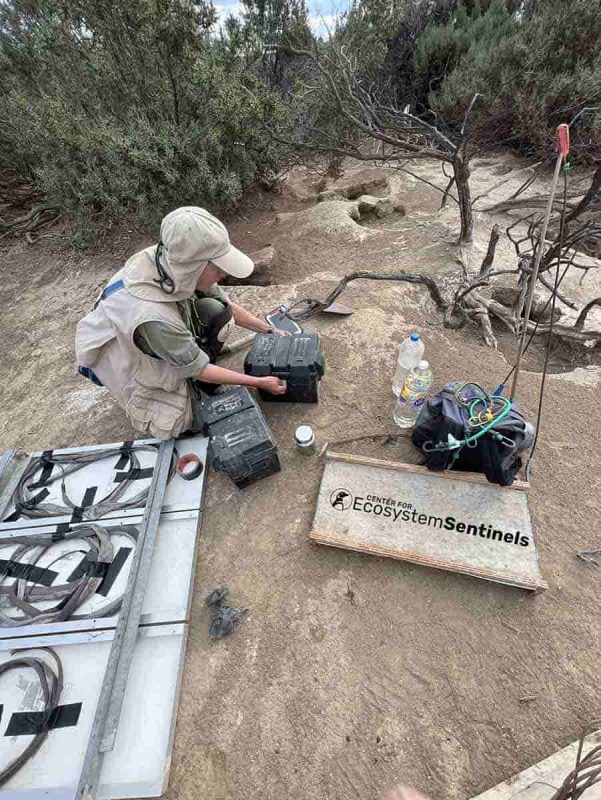
Oil spills have thankfully become less frequent but human activity is a constant threat to vulnerable land burrowing animals.
In 2022, one resident of Punta Tombo terrorized the penguins when he unilaterally decided to create a road to the beach from his ranch. He bulldozed over groups of penguins and crushed dozens of nests. Criminal charges are pending.
The penguins have many human helpers too, among them many local volunteers.
In 2023 Mundo Marino Foundation rescued and rehabilitated 15 Magellanic penguins, weakened by malnutrition and ingestion of plastic waste.
After penguin rehab, they all successfully waddled out to sea (video, opens in new window).
Punta Tombo may have hosted one million penguins before long-term research began, today there are an estimated quarter 200 million to 250 million breeding pairs.
Growing penguin colonies on the gulfs along Peninsula Valdes, most notably, San Lorenzo ranch (described below) somewhat make up for the population decline at Punta Tombo.
But these seabirds of the Southern Hemisphere have no protections if they settle on private lands, which highlights why publicly-owned nature reserves such as Punta Tombo are so crucial.
Punta Tombo: Day Trip from Puerto Madryn
Punta Tombo is just 180 km (112 mi), or a two-and-a-half-hour drive from Puerto Madryn.
Puerto Madryn serves as the main hub for tourism in the area and is 1,075 kilometers (668 mi) south of Buenos Aires.
There are two main ways to get to Punta Tombo from Puerto Madryn:
1. Book a Group Excursion or Private Tour
An organized tour is ideal for single travelers or a group who don’t want to brave the (partially unpaved) roads alone.
A. Group Tour
A group tour comes with the benefit of a local, licensed guide.

Book a tour from Puerto Madryn to see penguins in their natural habitat
The biggest drawback to group excursions is there is a set schedule so there isn’t as much freedom.
B. Private Tour
A better, albeit more expensive option is a customizable, private Punta Tombo tour.
An exclusive private tour is ideal for those who don’t want to rent a car for whatever reason but also want the freedom to determine how much time is spent at each location.
Tour for Cruise Passengers
For cruise passengers anchoring in Puerto Madryn, there is an exclusive day-long tour that starts bright and early but includes several destinations.
2. Rent a Car to Get to Punta Tombo
Renting a car to go to Punta Tombo is awesome because it gives you the freedom to take your time and also check out nearby original ‘Welsh colonies’ on the way.
Renting a vehicle is less expensive than taking a tour for a group of three or more.
Cars can be rented at the airport in Trelew or in Puerto Madryn.
A tourist visa, credit card, and a valid foreign license are all that’s needed to get some wheels, but be aware that almost all the cars in Argentina have standard transmissions.
See this post about ➡ driving and renting a car in Argentina to learn more about the requirements, driving laws, and types of cars available.
How to get to Punta Tombo: Driving Instructions
To visit Punta Tombo you’ll first have to get to Puerto Madryn, a two-hour flight south of Buenos Aires or an overnight bus ride.
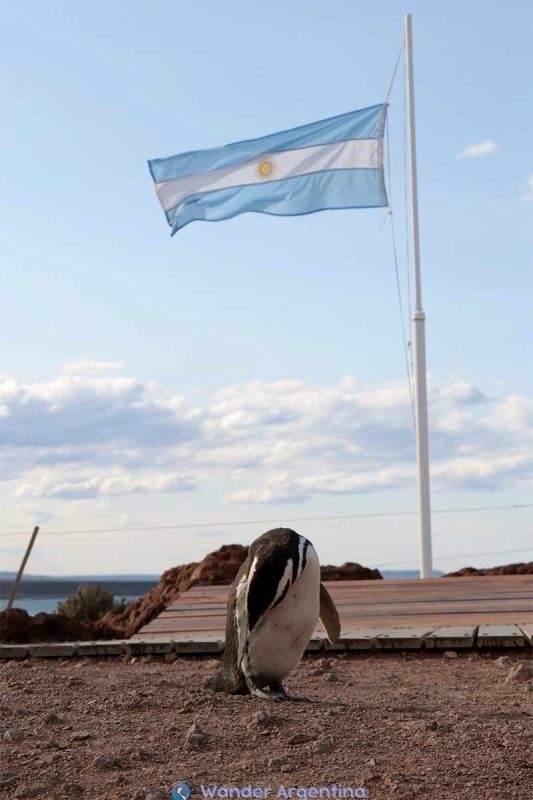
To get driving instructions to Punta Tombo by car from Puerto Madryn, you can use Google Maps if you have data.
Just make sure that the instructions are correct because they often aren’t in rural Argentina.
Distance from Puerto Madryn to Punta Tombo
190 kilometers (about 118 miles).
🚘 2.5 hours 🚌 3 hours
The total distance is approximately 190 kilometers (118 miles), and the whole trip is on signposted, paved roads until you get there.
- Start on Road No. 3: Head southwards from Puerto Madryn on Road No. 3. This part of the journey involves a well-maintained, paved highway. Be mindful of occasional wildlife crossings.
- Turn at the Roundabout: After approximately 100 kilometers. Just move right in and
take the lefthand exit to continue onto Road 75. This section is also paved and generally in good condition, although it’s narrower than Road No. 3. - Transition to Road One: Continue on Road 75 for around 22 kilometers (13.6 mi) until you reach a junction with Road One. This road might have some rough patches, so drive carefully. It’s a less traveled road but still navigable for most vehicles.
- Final Stretch on Gravel Road & Arrival at Punta Tombo:: Finally, turn onto the gravel access road leading to Punta Tombo. This last part of the journey, approximately 20 kilometers (12.4 miles), is all gravel. It can be bumpy and dusty, so driving slowly is advisable.
A vehicle with good suspension and higher ground clearance is ideal, although standard cars will be fine in nice weather conditions during spring and summer.
Punta Tombo National Reserve Visitors Center
At the entrance to the reserve, there is a small entrance fee, that goes toward maintenance and conservation efforts.
The circular Tombo Center is a visitors’ information center with installations about the penguins and basic amenities such as restrooms and a small café.
Everyone knows Argentina’s money situation is volatile, but the entrance fee to Punta Tombo hovers around only U.S. $3-10 for international tourists.
The Trails & Landscape
Once finally nearing the coastal nesting ground at Punta Tombo, the landscape transforms into a lively scene, with the distinctive calls of the Magellanic penguins creating nature’s version of Carnival.
Set upon a dry, open landscape upon sandy substrate the reserve allows penguins to saunter out to sea and return without human interference.
The wooden footbridges over the migration path ensure their passage to and from the ocean remains undisturbed.
The penguins are so accustomed to humans that they approach and seem to nod ‘hello,’ although during incubation they guard over their one or two eggs diligently.
It can’t be recommended enough to walk the whole 1.6 km (one mile) path along the coastline for the full experience.
Magellanic penguins are fascinating birds and seeing them in their natural habitat and going about their lives is an enchanting experience you’ll never forget.
Beyond Punta Tombo: Other Penguin Hubs Near to Puerto Madryn
Penguins can be spotted all along the Atlantic Coast here, especially along the coastal beaches.
To observe other species of penguins in Argentina, such as Gentoo, Southern Rockhopper, and the occasional King or Macaroni penguin, you’d have to venture further south, into the land of icy glaciers that Patagonia is known for worldwide.
Peninsula Valdes also has a large concentration of penguins, with several rookeries on the coasts. Here are some of the colonies on the peninsula:
Punta Cantor
The Punta Cantor viewpoint in Caleta Valdés is along the eastern coast of the Valdes Peninsula, 88 kilometers (55mi) from Puerto Piramides,
This rookery is free to observe and allows a panoramic view against the backdrop of the sea.
If it’s high tide you’ll also see the massive elephant seals sunbathing and if it’s the right time of year might spot killer whales circling nearby looking for delicious seal treats.
Punta Norte: Estancia San Lorenzo
San Lorenzo ranch along the San Matías Gulf claim the largest penguin colony on Peninsula Valdes.
Penguins started colonizing this area beginning in the 1970s as their favorite treat, anchovies are in large supply in the area.
The private San Lorenzo ranch near Punta Norte is reached by a long gravel road.
Locals express disappointment that it is privatized but Penisula Valdes’ World Heritage Site status means owners have no choice but to embrace the penguins that take over their land.
It’s preferable to go to Punta Tombo, but for those who have a short time in the area, there is also the option of San Lorenzo’s ‘Land of Penguins’ guided tour where visitors immerse themselves amid thousands of penguins as they go about their daily activities.
Estancia San Lorenzo Land of Penguin Tour:
September — March
Three tours a day: 11:00 a.m., 2:00 p.m., and 4:00 p.m.
Punta Ninfas: Newer Penguin Colony South of Puerto Madryn
Within the last decade, another 6,000 penguins took a cue from the Welsh settlers in the region 😄 and set up a new colony on the southern coast of the Golf Nuevo.
Punta Ninfas (Nymphs Point) isn’t on Peninsula Valdes but at the southern point of Golfo Nuevo, 75 kilometers (47 mi) southeast of Puerto Madryn.
Primarily known for its 1916 lighthouse, Punta Ninfas contains one of the newer colonies, accessible via the beautiful Estancia El Pedral.
This full-day tour to El Pedral from Puerto Madryn provides transport to and from Puerto Madryn.
It includes stops to see sea lions and elephant seals at Punta Ninfas, and allows quality time with the penguin settlers, a typical delicious Patagonian asado (barbecue) lunch and Welsh tea.
It’s an ideal tour to see a lot of the area attractions in one day and has a reputation for being more respectful of the wildlife than the San Lorenzo Ranch below.
Visitors can also stay the night at the Estancia, but reservations are required.
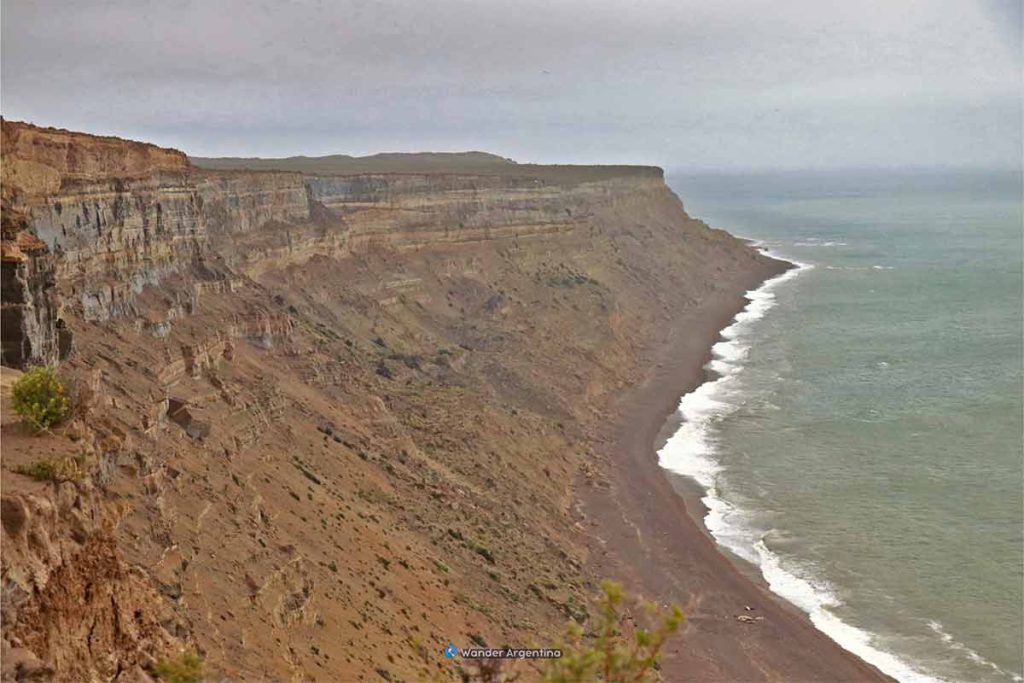
Dos Bahías Cape Rookery
South of Punta Tombo and roughly 30km southeast of the tiny town of Camarones, the secluded rookery at Cabo Dos Bahías offers a tranquil and remote alternative to Punta Tombo.
Including a vast penguin colony, this area is also home to a significant population of guanacos and rheas, adding to its wildlife diversity.
Cabo Dos Bahías not only promises penguins and whales at the right times of the year, but the groovy waves attract surfers.
The waves are a little more intimidating in winter, not the least because killer whale sightings are common. But with few people around, Cabo Dos Bahías provides an intimate and undisturbed experience with nature.
Other Activities Around Punta Tombo
While in the area, most travelers also go whale watching (when in season) and/or visit sea lion colonies.
Each wildlife experience provides a thrilling experience, spotting animals you’re looking out for and others that spontaneously appear.
Whether it’s a lone guanaco or a pack of Commerson’s dolphins crossing paths with the boat, each wildlife encounter adds a new insight into the vastness of marine life and the abundance of creatures that inhabit earth.
If not visiting on a tour already, the ‘Welsh Villages’ of Trelew and Gaiman are worth a detour on the way back to Puerto Madryn.
Try to make it at tea time (called ‘merienda‘ in Argentina) to enjoy delicious Welsh pastries from the old country.
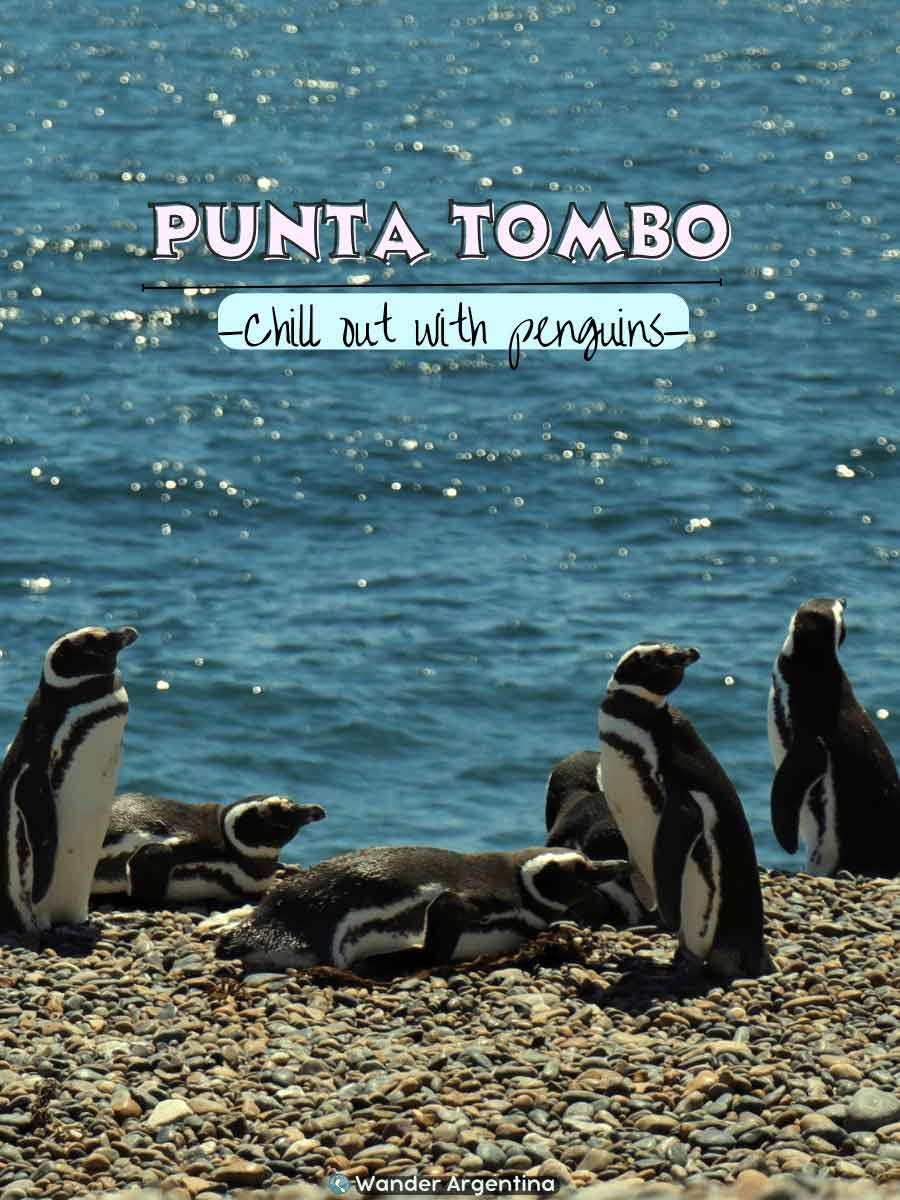
Whether heading to Punta Tombo straight from Puerto Madryn, or on a quest to see all the local wildlife in the area, you will be sure to leave here with happy feet.
TL/DR: Punta Tombo is the best place to observe Magellanic penguins in Argentina for the care at the reserve and the convenience of reaching it.
There are group tours and private tours available or you can DIY it and rent a car.
